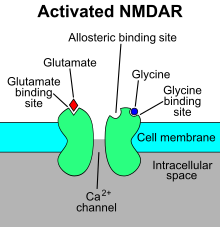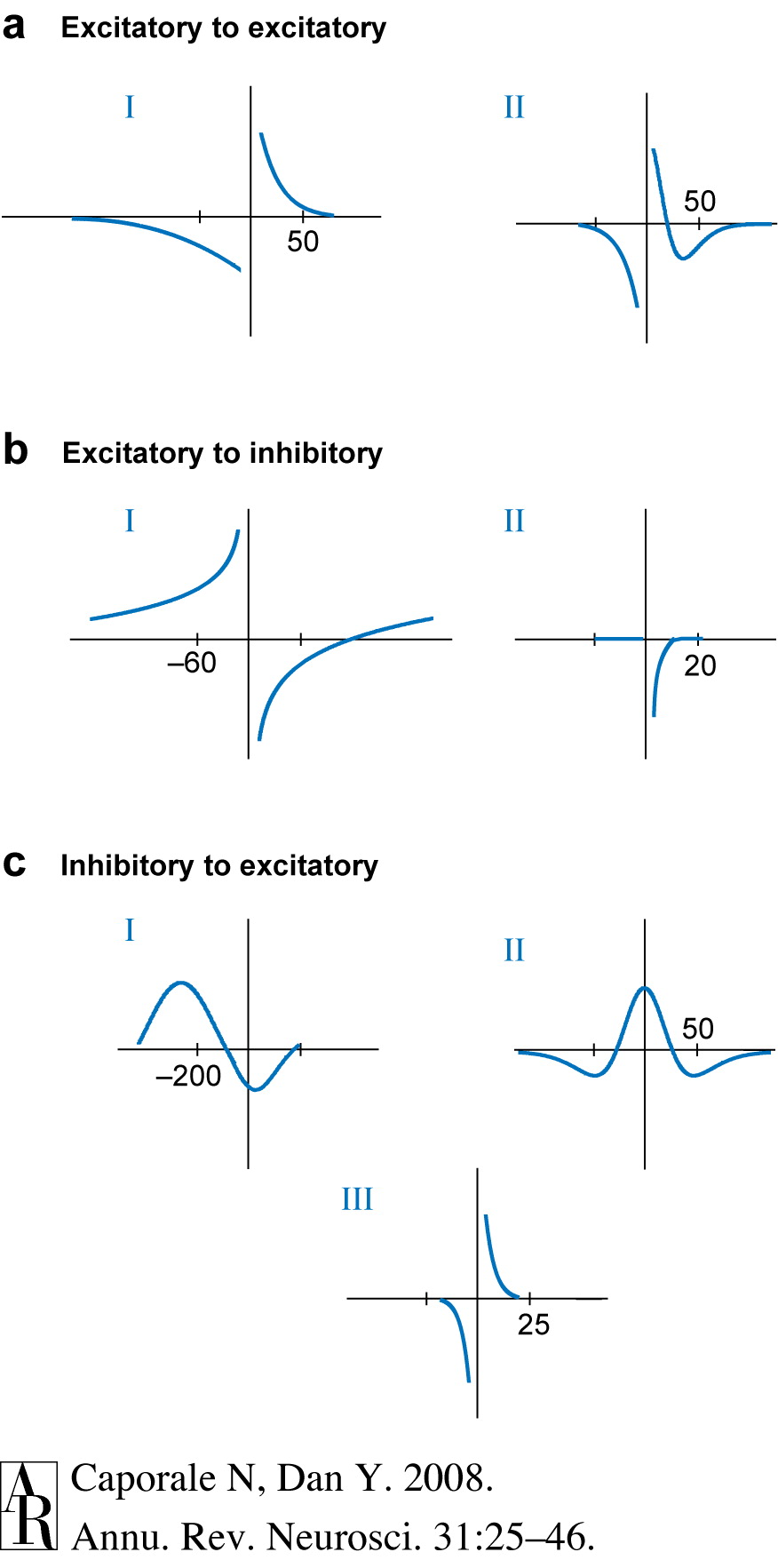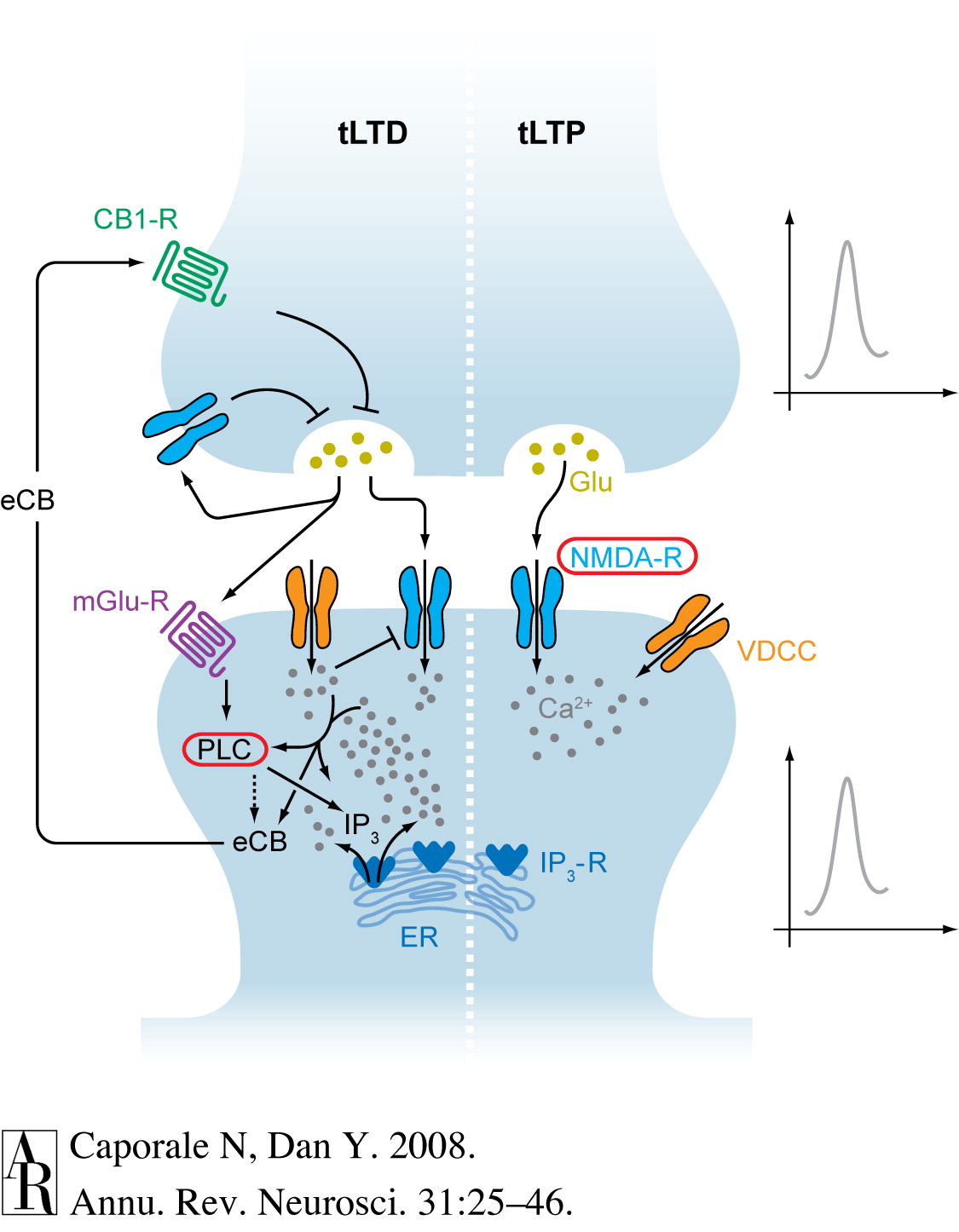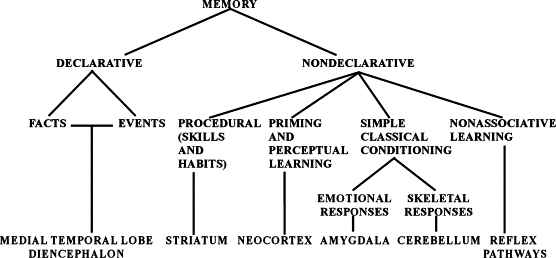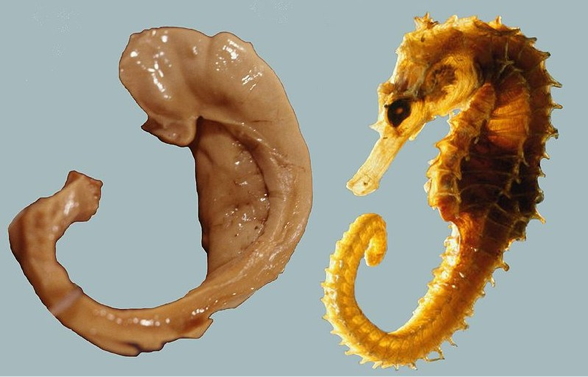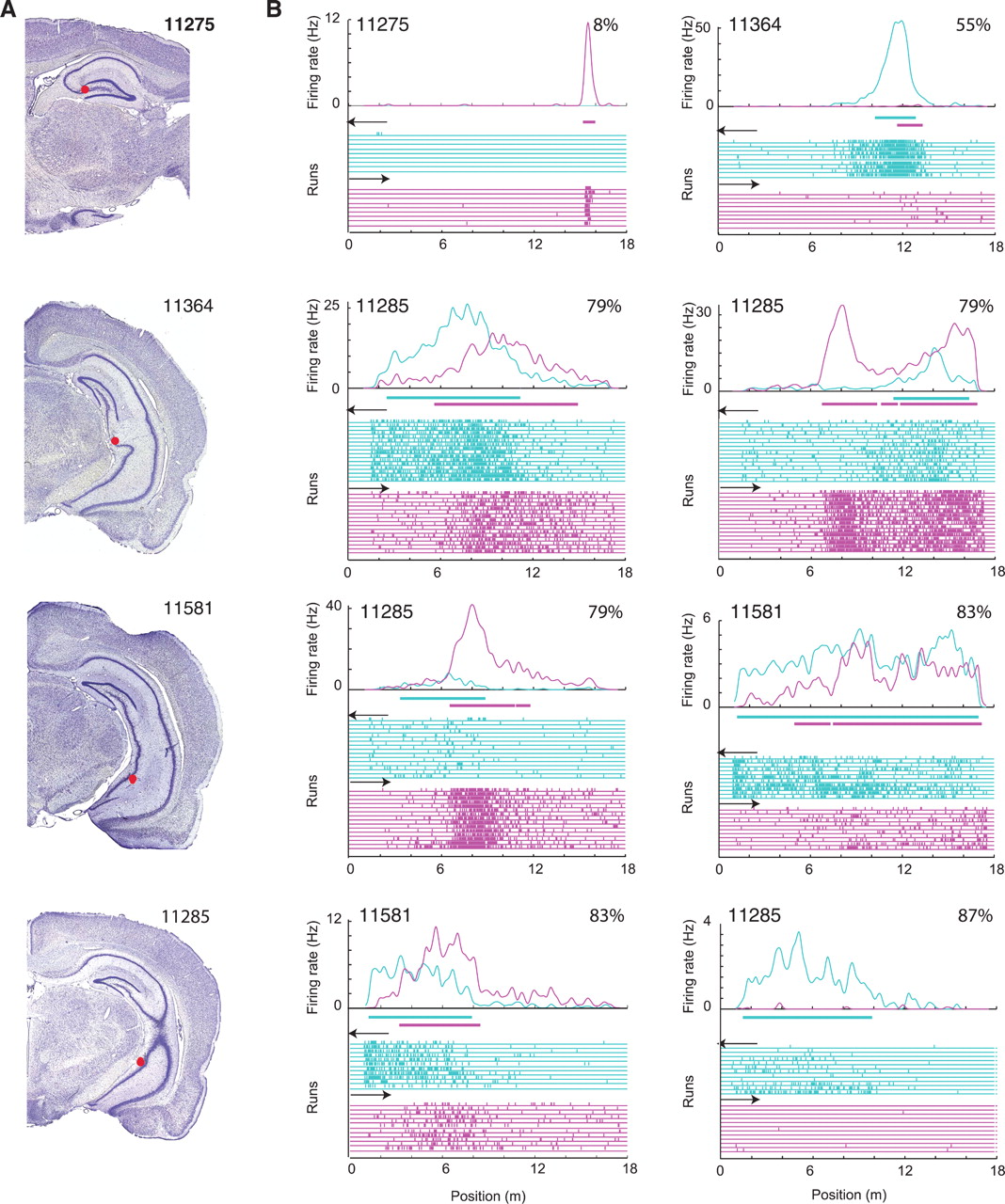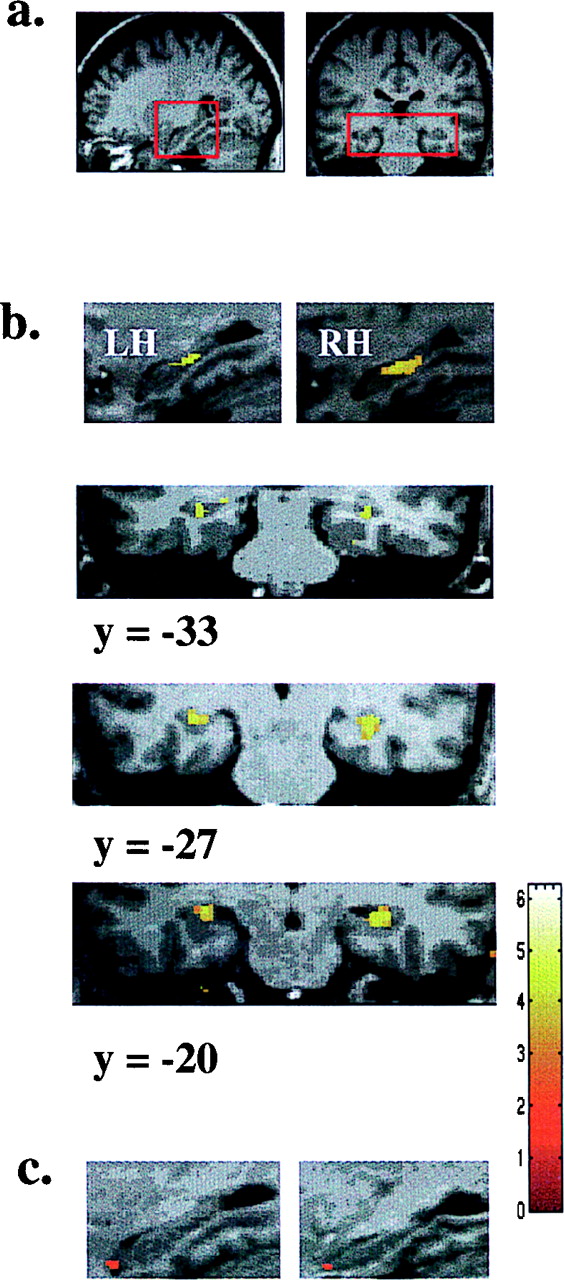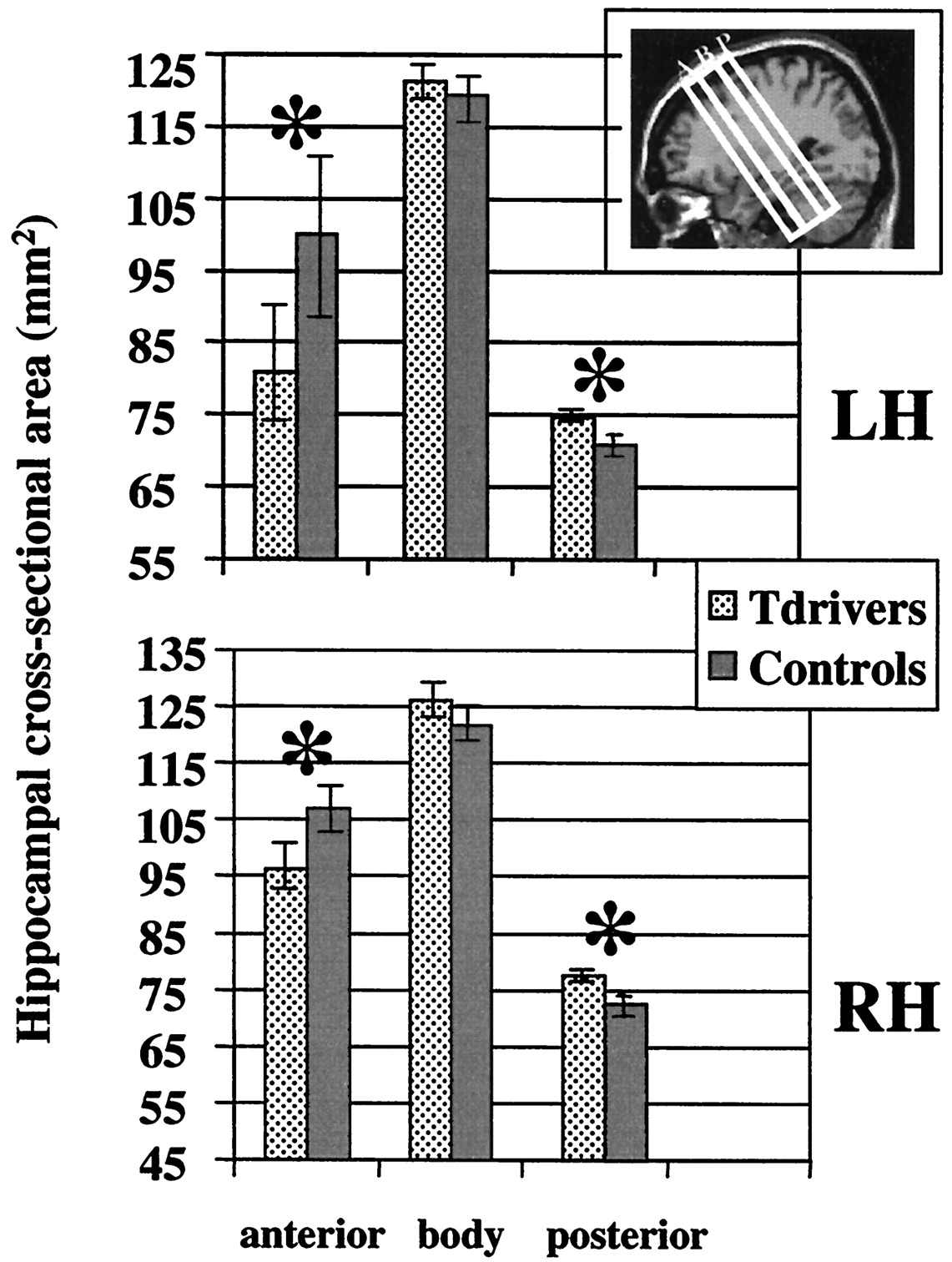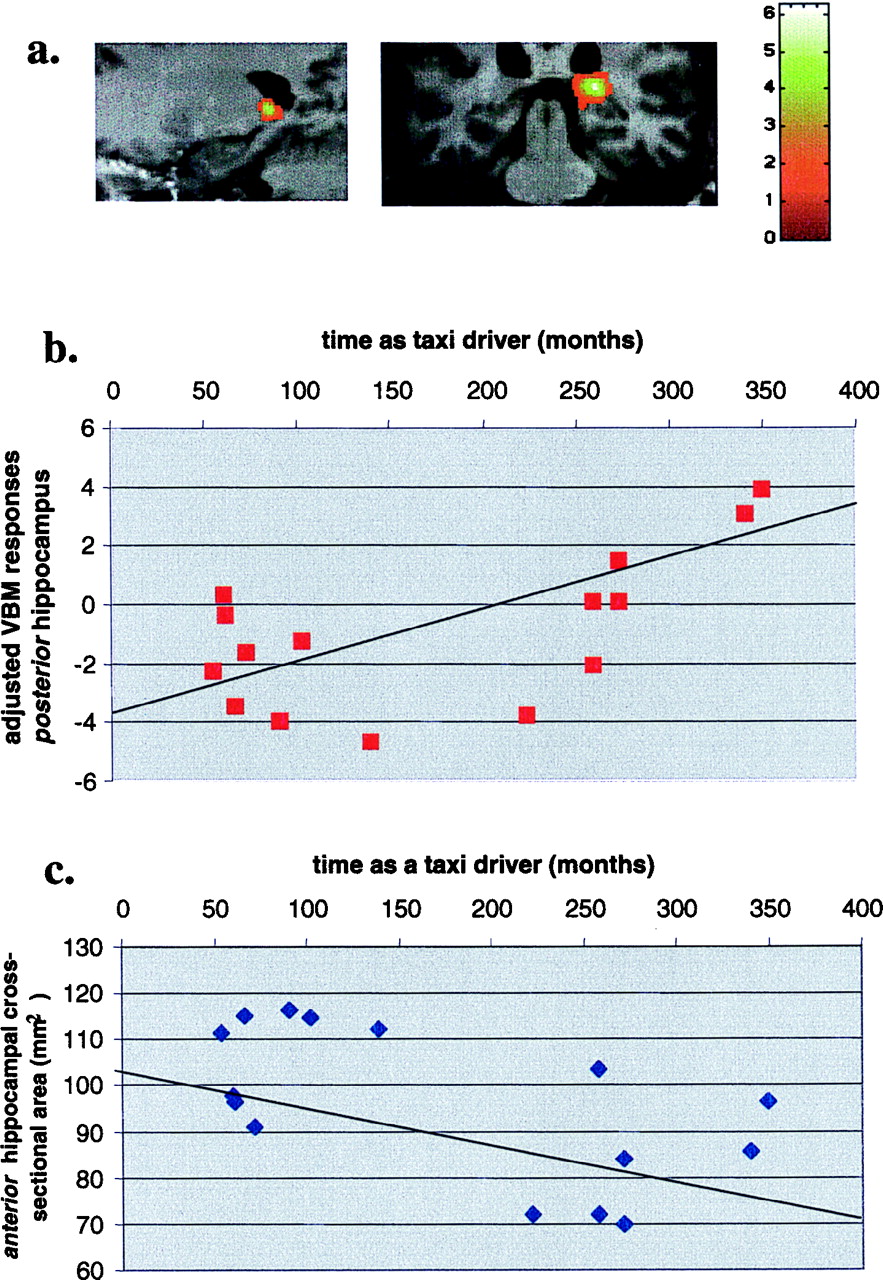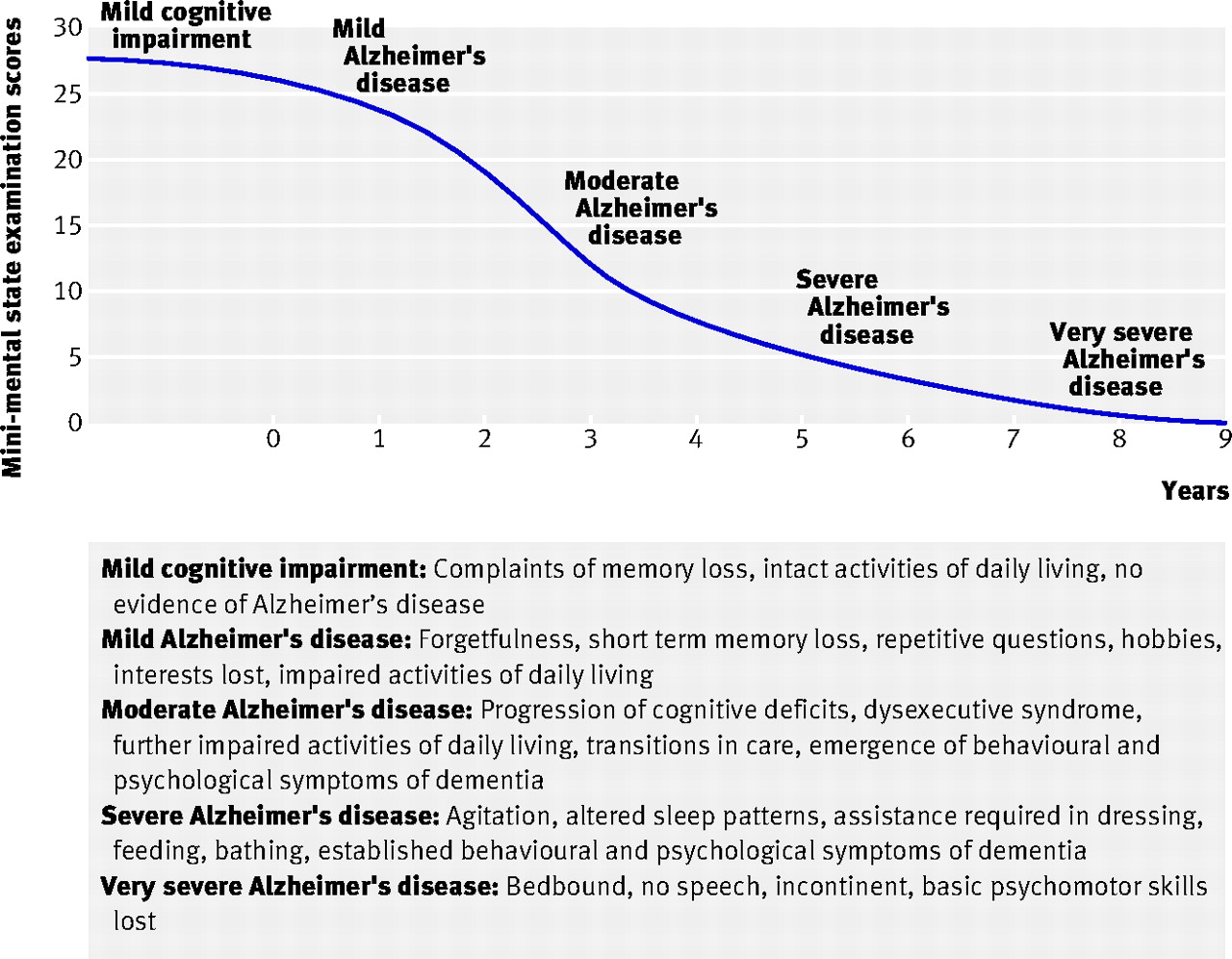2018-10-26 12:11:43
Prelude
Today's Topics
- Wrap-up on language
- Learning & memory
Memory capacity of the human brain?
Memory capacity of the human brain?
- 1e12 neurons
- 1e3 synapses/neuron
- 1e15 synapses or 1.25e14 bytes
- 1e9 gigabyte, 1e12 terabyte, 1e15 petabyte
http://www.scientificamerican.com/article.cfm?id=what-is-the-memory-capacity
What is learning?
What is learning?
- Q: Acquisition of new or change in existing knowledge, skills, …
- Non-associative
- \(A(t+1) = f(A(t))\)
- Habituation (\(\dot f < 0\)), sensitization (\(\dot f > 0\))
- Associative
- A -> B
- Classical & operant/instrumental conditioning
- Sequence, observational, episodic, semantic
What is memory?
What is memory?
- A: Information encoding, storage, retrieval
- Dimensions
- Short vs. long-term
- Working memory ~ short-term maintenance for guiding action
- Explicit (declarative: semantic vs. episodic) vs. implicit (procedural)
- Retrospective (from the past) vs. prospective (to be remembered)
- Recognition (familiar or novel) vs. recall
- Short vs. long-term
Biological bases of L&M
- Changes in patterns of neural activity
- Changes in connectivity
- New synapses
- Altered synapses (strengthened or weakened)
Computers vs. brains
- Computers have separate memory stores; brains store info everywhere
Donald Hebb's Insight
When an axon of cell A is near enough to excite cell B and repeatedly or persistently takes part in firing it, some growth process or metabolic change takes place in one or both cells such that A’s efficacy, as on of the cells firing B, is increased. (Hebb, 1949, p. 62)
Neurons that fire together wire together. (Lowell & Singer, 1992, p. 211).
'Hebbian' learning via NMDA receptor
- N-methyl-D-aspartate receptor (NMDA-R)
- 'Coincidence' detector
- Sending cell has released NT
- Receiving cell is/has been recently active
'Hebbian' learning
- Chemically-gated AND
- Ligand- (glutamate/aspartate + glycine) gated
- Sending cell active
- Voltage-gated
- \(Zn^{++}\) or \(Mg^{++}\) ion 'plug' removed under depolarization
- \(Na^+\) & \(Ca^{++}\) influx; \(K^+\) outflux
- Receiving cell responds
NMDA receptor figure
NMDA clinical significance
- Memantine (Alzheimer's Disease treatment) blocks NMDAR
- Controls over-activation and \(Ca^{++}\) excitotoxicity?
- Implicated in effects of phencylidine (PCP)
- Link to glu hypothesis of schizophrenia?
NMDA clinical significance
- Ketamine is NMDA receptor antagonist
- anesthesia, sedation pain relief
- possible short-term relief for depression
- Analgesic effects of nitrous oxide (laughing gas; NO)
- Ethanol inhibits (Ron & Wang, 2011)
But how to learn/remember "causal chains"?
- e.g., lightning THEN thunder
- unusual food THEN indigestion
Spike-timing-dependent plasticity
Spike-timing-dependent plasticity
Spike-timing-dependent plasticity
- A before B: strengthen A->B
- A after B: weaken A->B
- Neural Plasticity
- Lasting changes in neural firing, connectivity
- NMDA receptor molecular mechanism for implementing LTP and spike-timing-dependent plasticity
NMDA receptor function may vary by location on neuron
- Long-term potentiation (LTP)
- Synaptic NMDA receptors
- Long-term depression (LTD)
- Extrasynaptic NMDA receptors
- Lowered level of synaptic receptor activation
LTP discovery (Bliss & Lømo, 1973)
- Granule cell neurons in hippocampus dentate gyrus (DG)
- \(\theta\) band (10–20 Hz) stim for 10–15 sec, or 100 Hz stim for 3–4 sec
- shortened response latency, increased EPSP, increased population response over minutes or hours
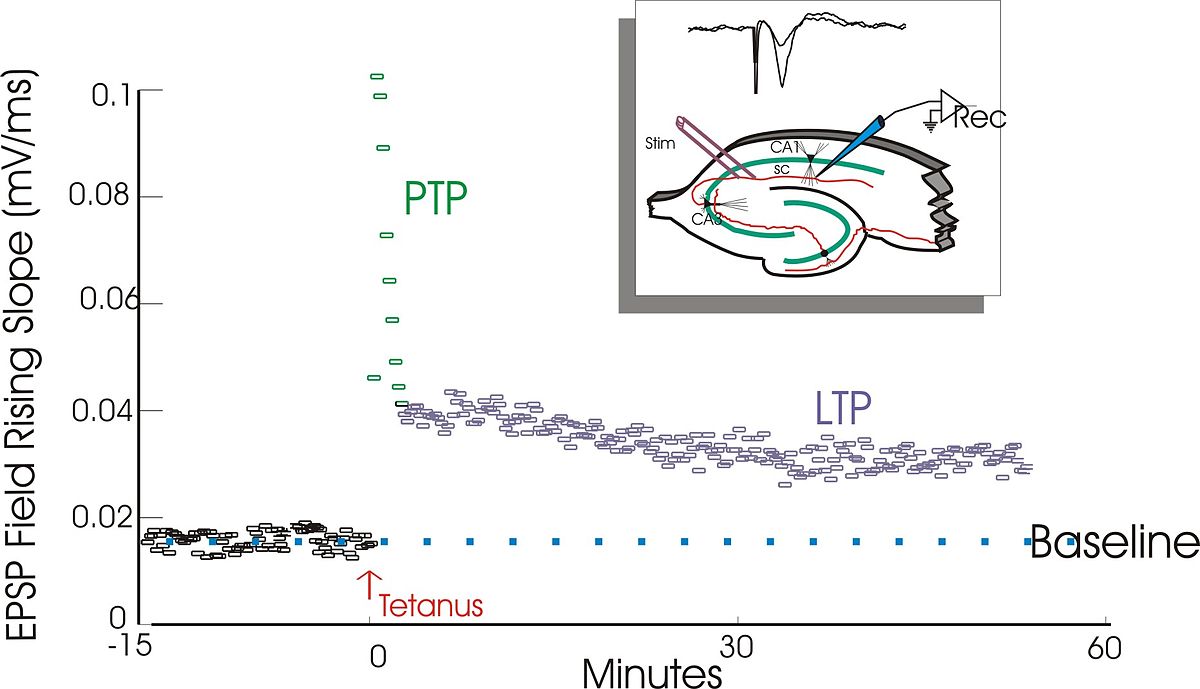
Mechanisms of LTP plasticity
- number of synaptic receptors
- quantity of NT released
- effectiveness of postsynaptic response
Pathways to plasticity
- \(Ca^{++}\) entry activates protein kinases (CaMKII and PKAII)
- Early LTP
- protein kinases phosphorylate (add \(P\) group to) postsynaptic AMPA receptors
- Increased current flow through AMPA (glu) receptors
- Late LTP
- insertion of new receptors into membrane
- Retrograde signal generator influences presynaptic response


Dimensions of stored info
- Memory of what or how recalled/recognized
- Facts/events/places/feelings vs. skills
- Memory of when?
- Immediate vs. distant past
- Memory for how long?
- Seconds vs. years
Memory systems in the brain
Hippocampus
Hippocampus features
- Dense in NMDA receptors
- Central "hub" in network?
- No, based on anatomical or functional connectivity
- But yes, when modeling "information flow" (Mišić, Goñi, Betzel, Sporns, & McIntosh, 2014)
Hippocampus roles
- Formation, storage, consolidation of long-term episodic or declarative memories
- Stores info for later transfer to cortex
- "Engrams" form in hipp & PFC simultaneously, fade in PFC over time (Kitamura et al., 2017)
Hippocampus roles
- Spatial navigation
Spatial precision of place cells
Human analogue – (Maguire et al., 2000)
(Maguire et al., 2000)
(Maguire et al., 2000)
Hippocampal volume in food-caching birds
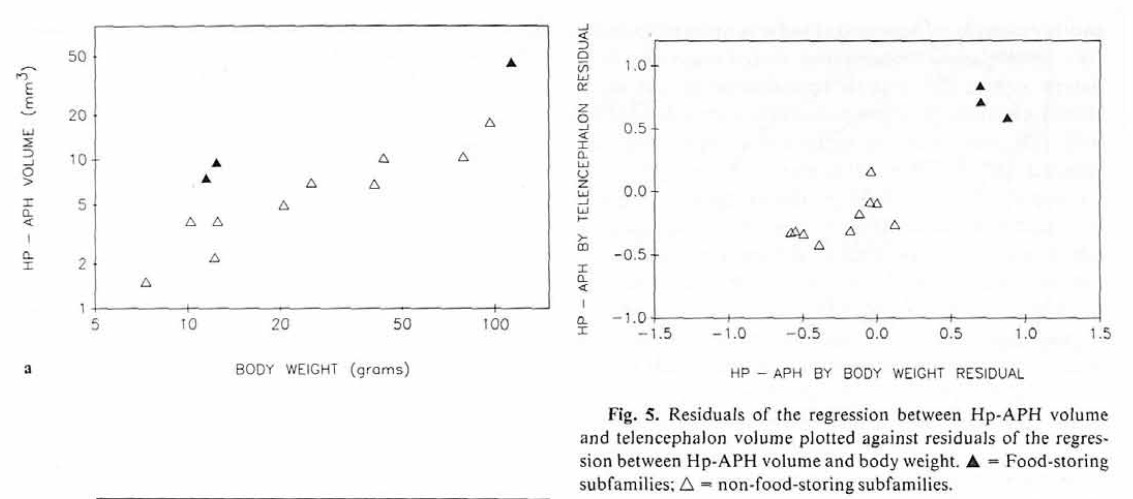
(Sherry, Vaccarino, Buckenham, & Herz, 1989)
Disorders of memory
Patient HM (Henry G. Molaison)
- Intractable/untreatable epilepsy
- Bilateral resection of medial temporal lobe (1953)
- Epilepsy now treatable
- But, memory impaired
- Lived until 2008
Brenda Milner tells the story
HM's surgery
Amnesia
- Acquired loss of memory
- ≠ normal forgetting
- Note: computers don't forget
HM's amnesia
- Retrograde amnesia
- Can’t remember 10 yrs before operation
- Distant past better than more recent
- Severe, global anterograde amnesia
- Impaired learning of new facts, events, people
- But, skills (mirror learning) intact
Types of amnesia
- Retrograde ('backwards' in time)
- Damage to information acquired pre-injury
- Temporally graded
- Anterograde ('forward' in time)
- Damage to information acquired/experienced post-injury
What it's like
Every day is alone in itself, whatever enjoyment I’ve had, and whatever sorrow I’ve had…Right now, I’m wondering, have I done or said anything amiss? You see at this moment, everything looks clear to me, but what happened just before? That’s what worries me. It’s like waking from a dream. I just don’t remember.
What it's like
Other causes of amnesia
- Disease
- Alzheimer’s, herpes virus
- Korsakoff’s syndrome
- Result of severe alcoholism
- Impairs medial thalamus & mammillary bodies
Patient NA
- Fencing accident
- Damage to medial thalamus
- Anterograde + graded retrograde amnesia
- Are thalamus & medial temporal region connected?
Patient NA
Spared skills in amnesia
- Skill-learning
- Mirror-reading, writing
- Short-term memory
- “Cognitive” skills
- Priming
What does amnesia tell us?
- Long-term memory for facts, events, people
- ≠ Short-term memory
- ≠ Long-term memory for “skills”
- Separate memory systems in the brain?
Alzheimer's Disease (AD)
- Chronic, neurodegenerative disease affecting ~5 M Americans
- Cognitive dysfunction (memory loss, language difficulties, planning, coordination)
- Psychiatric symptoms and behavioral disturbances
- Difficulties with daily living
- (Burns & Iliffe, 2009)
AD progression
AD
- Post-mortem exams show \(\beta\) amyloid plaques and neurofibrillary tangles
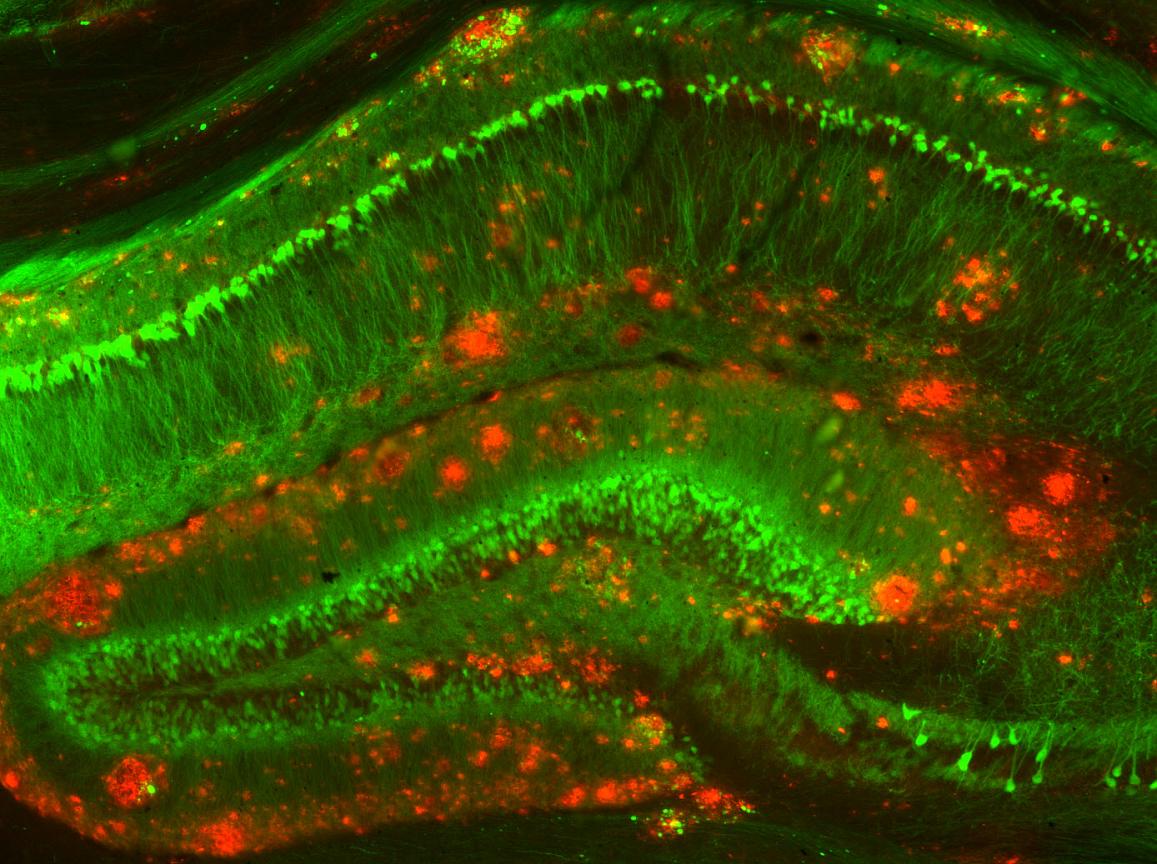
AD treatments include
- Acetylcholinesterase (AChE) inhbitors (e.g. Aricept)
- NMDA-R partial antagonists (e.g., Memantine)
- Drugs that address amyloid \(\beta\) don't work especially well
- AD the result of disordered immune response?
The other end of the spectrum…
What about working memory? (D’Esposito & Postle, 2015)
- LTM representations of target items + attention -> elevated activation
- Semantic items
- Sensorimotor items
- Capacity for attended items (in Focus of Attention or FoA) limited ~ 4
What about working memory? (D’Esposito & Postle, 2015)
- Neural basis
- sustained activation in PFC
- subthreshold activation in areas where items are stored
Individual differences in visual WM (Luck & Vogel, 2013)

Summary
- Multiple types of learning & memory
- Learning & memory distributed across the brain
- Hippocampus + PFC critical areas binding together sensory/semantic info stored elsewhere
- Changes in synaptic #, strength, connectivity provide cellular basis
References
Bliss, T. V. P., & Lømo, T. (1973). Long-lasting potentiation of synaptic transmission in the dentate area of the anaesthetized rabbit following stimulation of the perforant path. J. Physiol., 232(2), 331–356. Retrieved from http://onlinelibrary.wiley.com/doi/10.1113/jphysiol.1973.sp010273/full
Burns, A., & Iliffe, S. (2009). Alzheimer’s disease. BMJ, 338, b158. https://doi.org/10.1136/bmj.b158
Caporale, N., & Dan, Y. (2008). Spike timing-dependent plasticity: A hebbian learning rule. Annu. Rev. Neurosci., 31, 25–46. https://doi.org/10.1146/annurev.neuro.31.060407.125639
D’Esposito, M., & Postle, B. R. (2015). The cognitive neuroscience of working memory. Annu. Rev. Psychol., 66, 115–142. https://doi.org/10.1146/annurev-psych-010814-015031
Kitamura, T., Ogawa, S. K., Roy, D. S., Okuyama, T., Morrissey, M. D., Smith, L. M., … Tonegawa, S. (2017). Engrams and circuits crucial for systems consolidation of a memory. Science, 356(6333), 73–78. https://doi.org/10.1126/science.aam6808
Kjelstrup, K. B., Solstad, T., Brun, V. H., Hafting, T., Leutgeb, S., Witter, M. P., … Moser, M.-B. (2008). Finite Scale of Spatial Representation in the Hippocampus. Science, 321(5885), 140–143. https://doi.org/10.1126/science.1157086
Luck, S. J., & Vogel, E. K. (2013). Visual working memory capacity: From psychophysics and neurobiology to individual differences. Trends Cogn. Sci., 17(8), 391–400. https://doi.org/10.1016/j.tics.2013.06.006
Mišić, B., Goñi, J., Betzel, R. F., Sporns, O., & McIntosh, A. R. (2014). A network convergence zone in the hippocampus. PLoS Comput. Biol., 10(12), e1003982. https://doi.org/10.1371/journal.pcbi.1003982
Ron, D., & Wang, J. (2011). The NMDA receptor and alcohol addiction. In A. M. Van Dongen (Ed.), Biology of the NMDA receptor. Boca Raton (FL): CRC Press/Taylor & Francis. Retrieved from https://www.ncbi.nlm.nih.gov/pubmed/21204417
Sherry, D. F., Vaccarino, A. L., Buckenham, K., & Herz, R. S. (1989). The Hippocampal Complex of Food-Storing Birds. Brain, Behavior and Evolution, 34(5), 308–317. https://doi.org/10.1159/000116516
Squire, L. R. (2004). Memory systems of the brain: A brief history and current perspective. Neurobiology of Learning and Memory, 82(3), 171–177. https://doi.org/10.1016/j.nlm.2004.06.005
